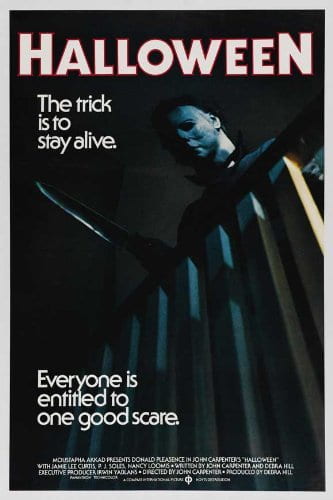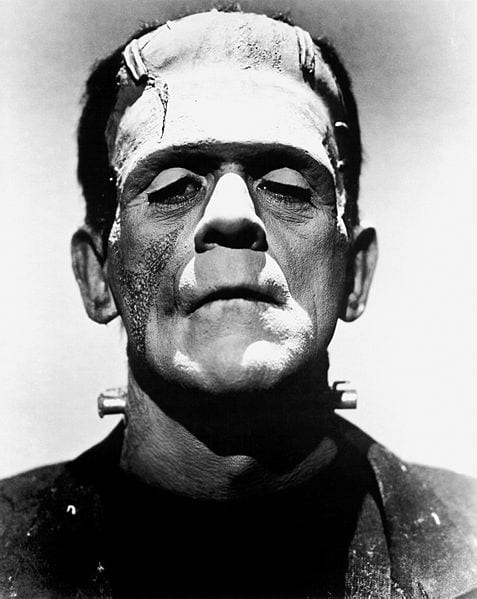Hey All!
Here’s a spooky movie review from Tatum Myers, student assistant at the Reference Desk. A perfect start to the day’s festivities!
In honor of Halloween and the 40 year anniversary of John Carpenter’s Halloween, I made it my mission to watch all 10 movies in the Halloween franchise. While I could on and on about each film from the disappointing Halloween III: Season of the Witch to the underrated Rob Zombie reboots; for the sake of time I will be reviewing what is in my opinion the best films in the franchise; Halloween (1978) and most recent retroactive sequel by the same name.

Carpenter’s vision for the film was to make a scary, nerve-racking ride designed with the sole purpose of leaving the audience shaking with fear. And the film did exactly that! Halloween became the single most successful independent production of the time and changed the perception of the horror movie industry. The film begins on Halloween night 1963, in the suburban town of Haddonfield, Illinois. Six-year-old Michael Myers, dressed in a clown costume, stabs his older sister Judith to death with a knife in their home. Fast forward fifteen years later on October 30, 1978, Michael’s psychiatrist Dr. Loomis arrives at Smith’s Grove Sanitarium to escort Michael to court. Noticing that the patients are wandering about, Loomis gets out of the car to investigate. Michael then steals Loomis’ car and returns home to Haddonfield. The next day, on Halloween, Michael begins to stalk Laurie Strode (played by Jamie Lee Curtis), a local babysitter who Michael sees dropping off the key to his childhood home for her realtor father. Throughout the day, Laurie becomes increasing aware of a “shape” following her around, but her friends are quick to dismiss her concerns.
Later that night Michael goes a brutal killing spree, murdering many of Laurie’s friends. The cinematography of these scenes are a visceral experience. The audience is not simply watching the movie, but having it happen to us. It’s easy to create violence on the screen, but it’s hard to do it well. Carpenter’s skilled eye for contrast and foreground allow him to set up the shots to execute a hyper-realistic scare. His direction of the characters paint them as all ordinary, everyday people. The performances are all the more absorbing because of that; the movie’s a slice of life that is carefully painted (in drab daylights and impenetrable nighttimes) before its human monster enters the scene. The film ends with a sense of dread that the very real threat of someone like Michael is still present, his body is suddenly missing from the final shot after seemingly being killed by Dr. Loomis. The characters and the audience are all in the same boat and that’s precisely the scariest part of the entire film.
Forty years later, director David Gordon Green puts a new coat of paint on the now iconic story of Michael Myers and Laurie Strode. 2018’s adaptive sequel of Halloween pins an aged alcoholic Laurie against Michael in hunter vs. prey plot line, but these roles get blurred as the film goes on. Jamie Lee Curtis resumes her role of Laurie, who is now a deeply troubled doomsday prepper with a heavily secured headquarter, ready for when Michael returns one day. The audience is still given the realistic overview of Laurie and her estranged daughter and granddaughter (played by Judy Geer and Andi Matichak) with the threat of Michael constantly in the back of everyone’s mind. By staying true to Carpenter’s original vision for the franchise, Halloween (2018) brings the best out of Laurie since the 1978 original– by making Laurie anything but a victim of Michael’s torment. But defeating Michael is not that simple for Laurie, and ultimately what grounds the insanity of the horror is the three generations of Strode women. The plot takes unimaginable twists and turns that neatly wrap together, leaving nothing more to be desired.
Green takes the audience on the same suspenseful journey of Laurie and Michael with different jump scares, moments of silence, and snippets of intense gore. While the film closely follows the slasher template by sending Michael on a slashing, slicing, murder spree through Haddonfield, Green adds an equally important perspective of mass tragedy and trauma through the lens of a survivor.

After watching every good, bad, and downright boring variation of Halloween, these films stand for the tried and true slasher films throughout the decades. If Universal’s 1931 Frankenstein is hailed as possibly one of the most important horror movies ever made, Halloween runs in a close second in revamping the genre. The film’s success reached across generations paving the way for films like Scream (1996), I Know What You Did Last Summer (1997), and Happy Death Day (2017).
